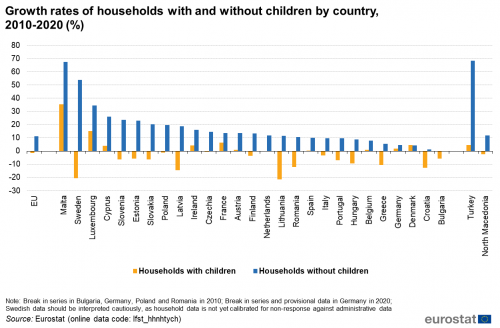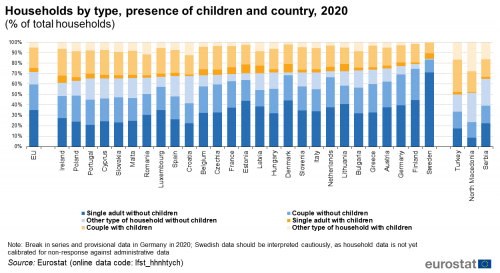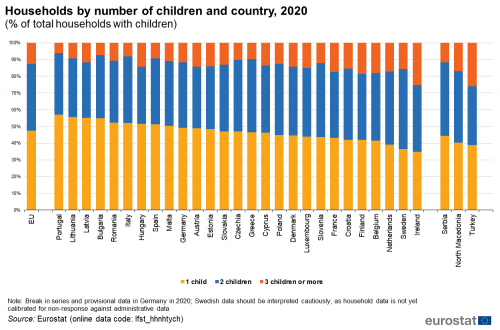What Is the Average Number of Kids in a Family?
Increasing number of households consisting of adults living alone
During the last decade i.eastward. 2010-2020, the total number of households in the Eu increased by 7.2 %. In 2020, the European Matrimony recorded 195.4 meg households with on boilerplate two.3 members per household. The largest average household size was recorded in Croatia (2.8 members) and in Ireland, Cyprus, Republic of malta, Poland, Romania and Slovakia (all with 2.6 persons in average) while the smallest was observed in Sweden[1] (1.5 members), followed past Kingdom of denmark, Germany**, Republic of estonia and Finland (each with two.0 members).
Between 2010 and 2020, only three European union Fellow member States remained unchanged in terms of household size (namely Grand duchy of luxembourg, Denmark and the Netherlands). All other EU Member States recorded a subtract in the average number of persons per household. The largest decreases since 2010 were observed in Sweden* with the average household size decreasing from 2.0 in 2010 to one.five members in 2020, Latvia (from two.vi to ii.2 members), Malta (from 2.nine to 2.vi members) and Republic of estonia (from two.3 to two.0 members).

Figure 1: Average number of persons per household past country, 2010 and 2020
Source: Eurostat (lfst_hhantych)
The development of household limerick over time shows some changes. Equally previously mentioned, the full number of households rose past seven.2 % between 2010 and 2020. However, single adult households (i.east. households consisting of simply i adult, living with or without children) increased much faster, namely past 19.5 % in the same period (see Figure 2). This growth is fifty-fifty more pronounced in single adult households without children (+twenty.3 %)(see Figure 3 for a comparison of 2010 and 2020 data by presence of children). Households fabricated of a couple (lawful unions or past contract), with or without children, registered a slower increase of 4.0 %. This growth is nigh entirely due to the higher number of couples living without children. Moreover, households with 2 (not existence a couple) or more adults, named also "other type of households" in this article (due east.g. an economically contained adult kid living with one or two parents, elderly person living with other members of the family unit, economically independent room mates), decreased past 7.iv % over the 2010-2020 period in the European union. The decrease in this blazon of household is even higher for households with dependent children (-15.vii %) than for those without children (-3.4 %).

Figure 2: Households by type in the EU, 2010 to 2020 (in millions)
Source: Eurostat (lfst_hhnhtych)

Figure three: Households by type and presence of children in the EU, 2010 and 2020
(in millions
Source: Eurostat (lfst_hhnhtych)
Relative differences in households for men and women, immature people and seniors
Looking at the increase in the developed population (run across Figure 4), the development over the terminal decade shows different patterns co-ordinate to age and sexual practice. With regard to single adults, both men and women recorded a higher number of people living alone for all age groups in 2020 compared to 2010. The growth is higher than x % for all categories except for young women anile 15-24. For both men and women, the proportion of unmarried adults increased faster than that of adults living in a couple. This concluding finding is observed for men and women of all historic period groups, autonomously from women aged 65 and more for whom a higher increase was recorded for those living in a couple (+fourteen.0 % for unmarried women aged more than 65 against +24.iii % for the same age women living in couple). In terms of gender, male adults living alone increased more steeply than female adults living lone, regardless of age group. Men aged 55-64 experienced the greatest increase in the period 2010-2020, with a 52.two % increase. For comparing, women in the same historic period category recorded an increase of 25.2 % since 2010. Older men anile 65 and over living alone increased by 40.five % in 2020 compared to 2010. The corresponding increment for women was fourteen.0 %.

Figure 4: Growth rates of the developed population past type of households, sexual practice and historic period in the Eu, between 2010 and 2020 (%)
Source: Eurostat (lfst_hhindws)
In addition to these developments, differences at EU level are also visible in the share of adults living lone, in a couple or in another type of household (i.east. with another adult but non as a couple or with several adults) according to the age group (see Figure 5). Around one-half of adults above 15 years former live equally a couple (respectively 48.3 % of women and 51.9 % of men). Nearly three in ten women and men lived in another type of household (respectively, 26.8 % and 29.one %). Women living alone deemed for one quarter of the total women (24.nine %) while men living alone accounted for almost one 5th of the total male population (19.0 %).
In the context of the European union-LFS, children are those aged up to 24 years old, living with adults and economically dependent. Looking only the adults aged between 15 and 24 years (and so those economically independent), the vast bulk of men (72.one %) live in another type of household (i.e. two, just not as a couple, or more adults) against 58.2 % of women. Some other difference amongst young adults is that around 1 in 5 female adults aged 15-24 live as a couple (18.9 %) while it is the case for fewer than ane in ten men in this age category (vii.vii %).
In the EU, xl.four % of women aged 65 or over alive alone compared with 19.8 % of men in the same category. Four out of 10 women (40.one %) and six out of ten men (62.9 %) live as a couple, probably because women on boilerplate live longer.

Effigy 5: Shares of the adult population past blazon of households, sexual activity and age in the European union, 2020
(% of the total adult population)
Source: Eurostat (lfst_hhindws)
Presence and number of children
In 2020, the EU recorded an increase of eleven.2 % in households without children and a decrease of 1.four % in households with children, compared with the state of affairs in 2010 (see Figure 6). At national level, all countries, with the exception of Republic of bulgaria which showed no change, recorded an increase between 2010 and 2020 in households without children, ranging from +67.6 % in Malta, +54.0 % in Sweden*, +34.6 % in Luxembourg and +26.2 % in Cyprus to +1.1 % in Croatia, +4.2 % in Denmark and +four.6 % in Germany**. Turkey besides recorded a abrupt increase (68.4 %) in households without children. Regarding households with children, the development is relatively disparate among the Member States: the number of households with children decreased in 17 EU Member States, with the largest subtract in Republic of lithuania (-21.3 %). Information technology remained stable in Spain, withal, and increased in 9 European union Member States, including Luxembourg and Republic of malta, where information technology increased by more than 15% (+15.i % and +35.four %, respectively).

Figure half dozen: Growth rates of households with and without children past state, betwixt 2010 and 2020 (%)
Source: Eurostat (lfst_hhnhtych)
The 2020 distribution of households shows that the share of households in which children live tin vary considerably from 1 country to another (see Figure 7). At EU level, around three in ten households (28.7 %) include children. At the elevation of the calibration, children lived in ane third or more of households in Ireland, Poland, Portugal, Cyprus, Slovakia, Malta, Romania and Luxembourg. In Sweden*, Finland, and Germany**, children were establish in less than one out of every four households.
More than two thirds of households with children consisted of couples (68.7 %). In some countries, it is by far the virtually common type of household with children: in Finland and Greece, couples correspond 83.9% and 79.2 % respectively of the total number of households with children, while the everyman share in the EU is observed in Latvia (46.6 %). In Serbia and North Macedonia, less than half of the households with children are couples (48.2 % and 40.9 %). These two candidate countries have the highest share of households consisting of 2 (not being a couple) or more than adults and that include children (46.three % in Serbia and 57.two % in North Macedonia). They are followed past the two EU Fellow member States Croatia and Romania, every bit well as Turkey, where more than than i-tertiary of households with children include two (who are not a couple) or more than adults. At EU level, these households accounted for 17.3 % of households with children, while this percentage is below 10 % in Estonia, Finland, Kingdom of denmark and Sweden*. In these countries except Finland (i.eastward. Republic of estonia, Denmark and Sweden*) simply also in Latvia, Republic of lithuania and France, unmarried parents represent more twenty % of households with children. In the whole European Union, unmarried parents deemed for xiv.0 % of households with children. Romania and Republic of croatia had the lowest proportions of unmarried parents, as did Serbia, Turkey and North Macedonia (all recording a percentage less than 7 %).
Among households without children in the European union in 2020, about half of them consisted of single adults (49.1 %), around one third are couples (34.six %) and xvi.3 % are households with two (not being a couple) or more adults.

Figure 7: Households by type, presence of children and country, 2020 (% of full households)
Source: Eurostat (lfst_hhnhtych)
Households with 1 kid are the near common among households with children. In 2020, in the European union, almost one-half of the households with children included one child (47.5 %). Portugal, Lithuania and Latvia showed the highest shares of households with one child, i.eastward. ranging between 55 % and 57 %. Yet, in Republic of ireland, Sweden* and the Netherlands, households with i child constituted less than twoscore % of households with children (see Figure eight).
At EU level, iv in ten households with children (39.9 %) included two children in 2020. Households with two children or more were most frequent in Republic of ireland, Sweden*, the Netherlands, Slovenia, Croatia and in North Macedonia. In those countries, there were more households with two children than with one child.
In the European union, 12.6 % of the households with children in 2020 consisted of households with three or more children. Ireland, Republic of finland, Kingdom of belgium, France, the Netherlands, Sweden* and Republic of croatia recorded the highest share of households with three children or more, all to a higher place 15.0 %; this was also the example of Due north Macedonia. In Portugal (half dozen.3 %), Bulgaria (7.iv %), Italia (8.1 %), Spain (9.three %), Lithuania (9.4 %) and Greece (9.8 %), less than one in ten households with children had iii children or more than.

Effigy 8: Households by number of children and country, 2020
(% of total households with children)
Source: Eurostat (lfst_hhnhtych)
Potential bear upon of the COVID-19 crisis on households
Looking at the changes betwixt 2019 and 2020 information at Eu level, the meaning increment in the number of children aged xv to 24 with a medium or high educational level attainment (as persons with full social and economic dependence of other household fellow member/-s) is i of the most relevant findings. Please notation that high didactics level refers in this article to tertiary education (levels five-8) and the medium level to the upper secondary and mail service-secondary non-third education (levels iii and 4).
Effigy 9 presents the evolution of persons aged 15 to 24 who attained a medium or a high education attainment level cleaved downwardly by their household situation. It clearly shows that the children category was the most prominent category in 2020 including 41.ii % of those people against 38.iii % i year earlier in 2019 and that category significantly increased from 2019 to 2020 (+viii.4 %) while the other categories decreased. For case, among people aged 15 to 24 with a medium or loftier level of didactics in 2019, the largest category was not the children, simply the adults living in other types of households (bookkeeping for 38.5 % in 2019 versus 37.7 % in 2020). In this case, it is assumed that people are socially and economically independent even living with other family members or other adults. This category decreased by 1.3 %. Furthermore, 12.viii % were single adults in 2020 against 14.2 % in 2019, reporting a subtract of 9.5 % in only one year. Adults aged fifteen-24 with a loftier or medium educational level and living equally a couple accounted for viii.three % in 2020 compared to nine.0 % in 2019. This category also decreased by vii.four % over this one-yr menstruum. In comparing to the pre-COVID state of affairs, these findings bear witness that there were significantly more young people with a medium or high educational level who were economically dependent on and lived with other adults in 2020.

Figure ix: Development of children aged xv-24 with medium or high level of education past blazon of households in the Eu, 2015-2020
Source: Eurostat (lfst_hhinded)
Source data for tables and graphs
-
 Households 2020 data and figures
Households 2020 data and figures
Data sources
Source: All statistics presented in this article are derived from the European Matrimony Labour Force Survey (EU-LFS). The European union-LFS is the largest European household sample survey providing quarterly and almanac results on labour participation of people aged 15 and over. It covers residents in private households and excludes those in commonage households. Conscripts in military or community service are not included in the results. The EU-LFS is based on the same target populations and uses the aforementioned definitions in all countries, which means that the results are comparable between the countries.
Under the specific topic 'Households statistics', the Eu-LFS currently covers statistics on household composition and number and size of households.
Reference period: Yearly results are obtained equally averages of the four quarters in the yr.
Definition: A child is divers as a household member aged less than 25 years and in full social and economic dependence from other household fellow member/-s (parents / adults).
Coverage: The results from the EU-LFS currently cover all European Union Fellow member States, the EFTA Member States of Republic of iceland, Kingdom of norway, Switzerland, every bit well equally the candidate countries Montenegro, North Macedonia, Serbia and Turkey. For Republic of cyprus, the survey covers but the areas of Republic of cyprus controlled by the Government of the Democracy of Republic of cyprus. Notwithstanding, EU-LFS household data are non available for Republic of iceland, Norway, Switzerland.
European aggregates: Eu refers to the sum of EU Fellow member States. If data are unavailable for a country, the calculation of the respective aggregates takes into business relationship the information for the aforementioned state for the almost contempo period available. Such cases are indicated.
Country notes: (*) Data for Sweden should be interpreted cautiously, as household data is non calibrated for non-response against administrative data. (**) In Federal republic of germany, since the first quarter of 2020, the Labour Strength Survey (LFS) has been integrated into the newly designed German microcensus as a subsample. Unfortunately, for the LFS, technical problems and the COVID-19 crunch has had a large bear upon on the data collection processes, resulting in low response rates and a biased sample. Changes in the survey methodology also led to a break in the information series. The published German information are preliminary and may be revised in the futurity. For more data, run into here.
Different articles on detailed technical and methodological data are bachelor through: EU labour force survey.
Context
In addition to the Labour Force Survey (LFS), the EU-Statistics on Income and Living Conditions (EU-SILC) is also a source of household statistics. The Eu-SILC is a multi-purpose instrument which focuses mainly on income. Notwithstanding, information on housing conditions, social exclusion, labour and instruction is also collected.
Source: https://ec.europa.eu/eurostat/statistics-explained/index.php?title=Household_composition_statistics
0 Response to "What Is the Average Number of Kids in a Family?"
Postar um comentário